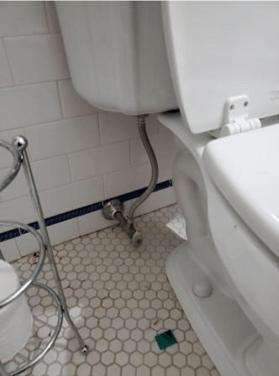Ways to Repair a Water-Damaged Wall in the Bathroom
Ways to Repair a Water-Damaged Wall in the Bathroom
Blog Article
Were you trying to find additional info around How to Repair and Prevent Bathroom Water Damage?

The bathroom is exceptionally susceptible for wet accumulation and also potential water damages due to the constant use of water in it. This article supplies basic evaluation techniques to aid finding water damage hazards.
The constant use of water in the bathroom makes it exceptionally prone for moist accumulation as well as possible water damage. By evaluating it on a regular basis, you can reduce water associated problems.
The complying with collection of evaluations is very easy to perform and also should be done once in every 3 months in order to keep your washroom in good shape and to avoid potential water problems caused by the bath tub, the shower, pipe joints and plumbing, sinks, cupboards, and the bathroom
Do not forget carrying out these examinations and be complete while performing them. Bear in mind that these straightforward inspections can save you a great deal of cash by offering very early indications for water damage
Bath tub and Shower
The shower and tub call for special interest and also maintenance. Inspect the floor tiles and also replace if broken. See to it that there is no missing grout between the floor tiles. Inspect and replace split caulking at joints where the wall surfaces fulfill the flooring or the bathtub. Blocked drains pipes and also pipelines problems will stop the bath tub from drying out and may suggest severe troubles beneath the bathtub. Speak with a specialist quickly to prevent structural damage. Take note of stainings or soft locations around the bath tub wall surfaces as they might indicate an internal leakage.
Plumbing
Signs for water damage are hard to spot because a lot of pipelines are set up inside the wall surfaces.
Pay unique focus to floor covering and also wall surfaces dampness and also discolorations as they might show an invisible plumbing trouble. Examine dampness degrees in adjacent areas too.
Sinks and also Cabinets
Sinks and also closets are revealed to dampness and also moisture day-to-day as well as are commonly ignored. Check on a regular basis under the sink and also on the counter top over it. Repair any type of drip in the trap as it may recommend drainpipe troubles. Check out the sink, slow-moving draining pipelines may indicate a blocked drain. Change sink seals if they are split or loosened.
The Bathroom
The toilet is a vulnerable water junction. Examine the water lines and also look for leaks around the toilet seat, in the tube, and also under the water tank. If you detect any kind of indicators of wetness on the floor around the toilet, look for leakages in the toilet rim and tank seals.
Realize that hanging bathroom bowl deodorants raises the opportunities for blockages.
How to Prevent Water Damage in Your Bathroom?
Water damage repair is an expensive, meticulous, and lengthy process. Unfortunately, bathrooms are the most susceptible rooms to water damage due to toilets, showers, and sinks. Pipes and fixtures wear out over time and are not immune to damage. But all is not lost, as there are ways to prevent water damage from occurring in your bathroom.
Check Your Plumbing
Nothing lasts forever, especially pipes, which can rust and begin leaking over time. You should periodically conduct pipe inspections and pay attention for any musty smells or water stains that may indicate you need water damage repair. Here are some things to check:
Frequently test valves for your toilet, shower, and sink to ensure they are properly working. Check faucet supply lines hidden under vanities and replace when needed. Replace cracked or deteriorating caulking along sinks, tubs, and showers. If you notice a clog in your sink, call in a professional. Since you can’t check the pipes in the wall, keep an eye out for stains, drywall bubbling, musty smells, and excess moisture; if the bathroom is on a second level, check the ceiling of the room directly below for these signs. Don’t Overwork Your Toilet
One of the most common reasons bathrooms need water damage repair is due to overflowing toilets. Save yourself the hassle of cleanup by being mindful and not pushing your toilet to extreme limits. If you have young children, it is especially important to keep an eye on them when they are in the bathroom and to teach them how to avoid clogging the toilet. Here are some more tips to help prevent your toilet from overflowing:
If you have a septic tank, only use septic-safe toilet paper Do not flush anything down the toilet besides toilet paper; items like diapers and sanitary napkins will clog the piping Pay attention to your toilet’s water level: If it’s low, it could mean it is partially clogged or that there is a crack in the toilet bowl Maintain Your Shower/Tub
Replace showers or tubs with cracks or other damage; even hairline cracks can allow water to seep in and cause damage. Grout and caulk help prevent water from seeping into walls and floors, so repair them if they are chipped, cracked, or deteriorating. Replace torn shower curtains or shower doors with seals that no longer work. Dry the floor and drain water from the tub immediately after use to prevent damage from sitting water. https://www.alure.com/home-improvements-blog/resources/how-to-prevent-water-damage-in-your-bathroom

As an enthusiastic reader about How to Repair and Prevent Bathroom Water Damage, I assumed sharing that segment was valuable. Sharing is nice. You just don't know, you may just be doing someone a favor. Thank you for your time. Don't hesitate to stop by our blog back soon.
Call Us Today Report this page